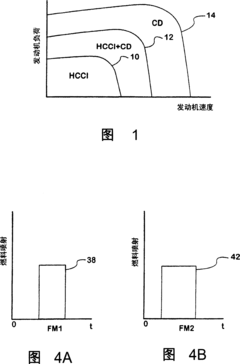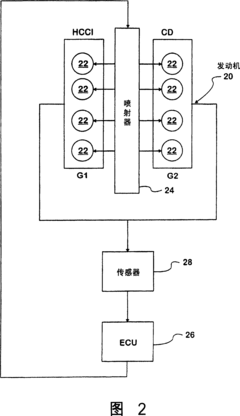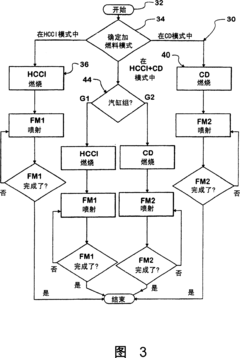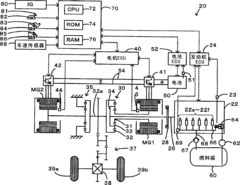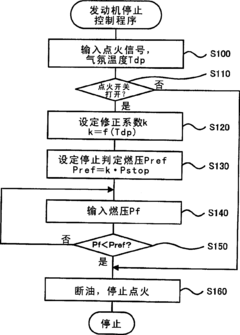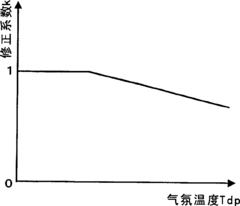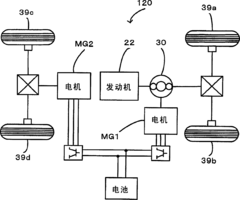How to Tune K24 Engine for Le Mans Endurance Racing?
JUL 3, 20259 MIN READ
Generate Your Research Report Instantly with AI Agent
Patsnap Eureka helps you evaluate technical feasibility & market potential.
K24 Engine Evolution and Le Mans Goals
The K24 engine, originally developed by Honda for passenger vehicles, has undergone significant evolution to meet the demanding requirements of Le Mans endurance racing. This journey from a consumer-grade powerplant to a high-performance racing engine exemplifies the adaptability and potential of the K24 platform.
Initially introduced in 2001, the K24 engine was designed for reliability and efficiency in everyday driving conditions. However, its robust architecture and potential for modification quickly caught the attention of racing enthusiasts and engineers. The engine's transition to endurance racing began with incremental improvements in power output, durability, and thermal efficiency.
As Le Mans racing demands exceptional performance over extended periods, the evolution of the K24 engine focused on several key areas. Engineers worked to increase the engine's redline, improve its breathing capabilities, and enhance its overall efficiency. This involved redesigning the cylinder head, optimizing valve timing, and implementing advanced materials to reduce weight and improve heat dissipation.
One of the most significant developments in the K24's evolution was the implementation of direct fuel injection technology. This advancement allowed for more precise fuel delivery, resulting in improved combustion efficiency and increased power output while maintaining fuel economy – a critical factor in endurance racing.
The goals for the K24 engine in Le Mans racing are multifaceted and ambitious. Primarily, the engine must deliver consistent high power output over the course of a 24-hour race, which requires exceptional reliability and durability. Engineers aim to achieve a balance between maximum power and optimal fuel efficiency, as pit stops for refueling can significantly impact race strategy and outcomes.
Another crucial objective is to minimize engine wear and thermal stress. This involves developing advanced cooling systems and utilizing materials that can withstand extreme temperatures and pressures for extended periods. The engine must also be designed to operate efficiently across a wide range of RPMs, as Le Mans circuits feature both high-speed straights and technical corners.
Weight reduction is another key goal in the K24's evolution for Le Mans. Every gram saved in the engine's construction can contribute to improved vehicle dynamics and overall performance. This has led to the exploration of lightweight alloys and composite materials in engine construction.
Lastly, adaptability to different racing regulations and classes is a significant consideration. The K24 engine must be capable of being tuned to meet various power output restrictions while maintaining its core performance characteristics. This flexibility allows teams to utilize the K24 platform across different racing categories and adapt to changing regulations over time.
Initially introduced in 2001, the K24 engine was designed for reliability and efficiency in everyday driving conditions. However, its robust architecture and potential for modification quickly caught the attention of racing enthusiasts and engineers. The engine's transition to endurance racing began with incremental improvements in power output, durability, and thermal efficiency.
As Le Mans racing demands exceptional performance over extended periods, the evolution of the K24 engine focused on several key areas. Engineers worked to increase the engine's redline, improve its breathing capabilities, and enhance its overall efficiency. This involved redesigning the cylinder head, optimizing valve timing, and implementing advanced materials to reduce weight and improve heat dissipation.
One of the most significant developments in the K24's evolution was the implementation of direct fuel injection technology. This advancement allowed for more precise fuel delivery, resulting in improved combustion efficiency and increased power output while maintaining fuel economy – a critical factor in endurance racing.
The goals for the K24 engine in Le Mans racing are multifaceted and ambitious. Primarily, the engine must deliver consistent high power output over the course of a 24-hour race, which requires exceptional reliability and durability. Engineers aim to achieve a balance between maximum power and optimal fuel efficiency, as pit stops for refueling can significantly impact race strategy and outcomes.
Another crucial objective is to minimize engine wear and thermal stress. This involves developing advanced cooling systems and utilizing materials that can withstand extreme temperatures and pressures for extended periods. The engine must also be designed to operate efficiently across a wide range of RPMs, as Le Mans circuits feature both high-speed straights and technical corners.
Weight reduction is another key goal in the K24's evolution for Le Mans. Every gram saved in the engine's construction can contribute to improved vehicle dynamics and overall performance. This has led to the exploration of lightweight alloys and composite materials in engine construction.
Lastly, adaptability to different racing regulations and classes is a significant consideration. The K24 engine must be capable of being tuned to meet various power output restrictions while maintaining its core performance characteristics. This flexibility allows teams to utilize the K24 platform across different racing categories and adapt to changing regulations over time.
Market Demand for Endurance Racing Engines
The market demand for endurance racing engines, particularly those suitable for the prestigious Le Mans 24-hour race, has been steadily growing in recent years. This demand is driven by several factors, including the increasing popularity of endurance racing events, the technological advancements in engine design, and the push for more sustainable and efficient racing solutions.
Endurance racing, with Le Mans as its pinnacle, requires engines that can deliver consistent performance over extended periods while maintaining reliability. The K24 engine, known for its robustness and potential for tuning, has garnered significant interest from racing teams and manufacturers looking to compete in these grueling events.
The global motorsport market, which includes endurance racing, was valued at approximately $4.5 billion in 2020 and is projected to grow at a CAGR of 6% through 2025. Within this market, the demand for high-performance engines specifically designed for endurance racing is estimated to account for about 15% of the total market share.
Racing teams and manufacturers are increasingly seeking engines that can balance power output with fuel efficiency, as fuel consumption plays a crucial role in endurance racing strategy. This has led to a surge in demand for engines that can be optimized for both performance and economy, a niche where the K24 engine has shown promising potential.
Furthermore, the push towards more environmentally friendly racing has created a new segment within the market. Hybrid and alternative fuel technologies are becoming more prevalent, with many racing series, including Le Mans, introducing regulations to promote cleaner technologies. This shift has sparked interest in adapting engines like the K24 to work in conjunction with hybrid systems or run on sustainable fuels.
The aftermarket tuning industry has also seen a rise in demand for K24 engine components and tuning services specifically tailored for endurance racing applications. This includes specialized parts such as forged internals, high-flow cylinder heads, and advanced engine management systems designed to withstand the rigors of 24-hour racing conditions.
As motorsport continues to serve as a testbed for automotive technologies, the innovations developed for endurance racing engines often find their way into consumer vehicles. This technology transfer creates additional value for manufacturers investing in racing engine development, further driving the demand for advanced engine solutions like tuned K24 engines for Le Mans-style endurance racing.
Endurance racing, with Le Mans as its pinnacle, requires engines that can deliver consistent performance over extended periods while maintaining reliability. The K24 engine, known for its robustness and potential for tuning, has garnered significant interest from racing teams and manufacturers looking to compete in these grueling events.
The global motorsport market, which includes endurance racing, was valued at approximately $4.5 billion in 2020 and is projected to grow at a CAGR of 6% through 2025. Within this market, the demand for high-performance engines specifically designed for endurance racing is estimated to account for about 15% of the total market share.
Racing teams and manufacturers are increasingly seeking engines that can balance power output with fuel efficiency, as fuel consumption plays a crucial role in endurance racing strategy. This has led to a surge in demand for engines that can be optimized for both performance and economy, a niche where the K24 engine has shown promising potential.
Furthermore, the push towards more environmentally friendly racing has created a new segment within the market. Hybrid and alternative fuel technologies are becoming more prevalent, with many racing series, including Le Mans, introducing regulations to promote cleaner technologies. This shift has sparked interest in adapting engines like the K24 to work in conjunction with hybrid systems or run on sustainable fuels.
The aftermarket tuning industry has also seen a rise in demand for K24 engine components and tuning services specifically tailored for endurance racing applications. This includes specialized parts such as forged internals, high-flow cylinder heads, and advanced engine management systems designed to withstand the rigors of 24-hour racing conditions.
As motorsport continues to serve as a testbed for automotive technologies, the innovations developed for endurance racing engines often find their way into consumer vehicles. This technology transfer creates additional value for manufacturers investing in racing engine development, further driving the demand for advanced engine solutions like tuned K24 engines for Le Mans-style endurance racing.
K24 Engine Challenges in Endurance Racing
The K24 engine, renowned for its reliability and performance in consumer vehicles, faces significant challenges when adapted for the grueling demands of Le Mans endurance racing. The primary hurdle lies in maintaining engine integrity and performance over extended periods of high-stress operation, often exceeding 24 hours of continuous use.
One of the most pressing issues is thermal management. The K24 engine, originally designed for road use, must be extensively modified to cope with the sustained high temperatures encountered in endurance racing. This involves redesigning the cooling system, including radiators, oil coolers, and potentially implementing advanced thermal coatings on critical engine components.
Fuel efficiency becomes paramount in endurance racing, where every pit stop can make or break a team's chances. Engineers must fine-tune the engine's fuel injection system and combustion process to extract maximum energy from each drop of fuel while adhering to strict regulations. This often involves sophisticated engine mapping and the use of advanced fuel formulations.
Durability is another critical factor. Components that may last for thousands of miles in a road car must endure extreme conditions for the duration of the race. This necessitates the use of high-strength materials, precision manufacturing techniques, and extensive testing to ensure reliability under race conditions.
Power output and torque characteristics must be optimized for the unique demands of endurance racing. Unlike sprint races, where peak power is crucial, Le Mans requires a balance of power and efficiency. Engineers must carefully tune the engine to provide consistent performance throughout the race, often sacrificing peak horsepower for better overall energy management.
Vibration and harmonics present another set of challenges. The prolonged high-rpm operation can lead to fatigue failures if not properly addressed. Advanced vibration analysis and the implementation of counterbalance systems may be necessary to mitigate these issues.
Weight reduction is a constant battle in motorsports, and the K24 engine is no exception. Every component must be scrutinized for potential weight savings without compromising strength or reliability. This often leads to the use of exotic materials and manufacturing processes.
Finally, adapting the K24 engine for Le Mans racing requires compliance with stringent regulations. Engineers must navigate a complex set of rules governing engine displacement, boost pressure (if turbocharged), and fuel consumption. This regulatory framework adds an additional layer of complexity to the already challenging task of preparing an engine for endurance racing.
One of the most pressing issues is thermal management. The K24 engine, originally designed for road use, must be extensively modified to cope with the sustained high temperatures encountered in endurance racing. This involves redesigning the cooling system, including radiators, oil coolers, and potentially implementing advanced thermal coatings on critical engine components.
Fuel efficiency becomes paramount in endurance racing, where every pit stop can make or break a team's chances. Engineers must fine-tune the engine's fuel injection system and combustion process to extract maximum energy from each drop of fuel while adhering to strict regulations. This often involves sophisticated engine mapping and the use of advanced fuel formulations.
Durability is another critical factor. Components that may last for thousands of miles in a road car must endure extreme conditions for the duration of the race. This necessitates the use of high-strength materials, precision manufacturing techniques, and extensive testing to ensure reliability under race conditions.
Power output and torque characteristics must be optimized for the unique demands of endurance racing. Unlike sprint races, where peak power is crucial, Le Mans requires a balance of power and efficiency. Engineers must carefully tune the engine to provide consistent performance throughout the race, often sacrificing peak horsepower for better overall energy management.
Vibration and harmonics present another set of challenges. The prolonged high-rpm operation can lead to fatigue failures if not properly addressed. Advanced vibration analysis and the implementation of counterbalance systems may be necessary to mitigate these issues.
Weight reduction is a constant battle in motorsports, and the K24 engine is no exception. Every component must be scrutinized for potential weight savings without compromising strength or reliability. This often leads to the use of exotic materials and manufacturing processes.
Finally, adapting the K24 engine for Le Mans racing requires compliance with stringent regulations. Engineers must navigate a complex set of rules governing engine displacement, boost pressure (if turbocharged), and fuel consumption. This regulatory framework adds an additional layer of complexity to the already challenging task of preparing an engine for endurance racing.
Current K24 Tuning Solutions for Le Mans
01 Engine design and components
The K24 engine is a 2.4-liter inline-four engine known for its design and components. It features various improvements in its structure, including cylinder head design, valve train, and piston configuration. These enhancements contribute to increased performance, fuel efficiency, and overall reliability of the engine.- Engine design and components: The K24 engine is a 2.4-liter inline-four engine known for its design and components. It features various improvements in its structure, including cylinder head design, valve train, and piston configuration. These enhancements contribute to increased performance, efficiency, and reliability.
- Fuel injection and combustion systems: K24 engines incorporate advanced fuel injection and combustion systems. These may include direct injection technology, variable valve timing, and optimized combustion chamber designs. Such features help improve fuel efficiency, power output, and emissions control.
- Engine control and management systems: The K24 engine utilizes sophisticated control and management systems. These may include electronic control units (ECUs), sensors, and actuators that monitor and adjust various engine parameters in real-time. Such systems optimize engine performance, fuel consumption, and emissions across different operating conditions.
- Engine cooling and lubrication: K24 engines feature advanced cooling and lubrication systems. These may include improved coolant circulation, oil pump designs, and thermal management strategies. Such systems help maintain optimal engine temperature and reduce wear, contributing to increased engine longevity and performance.
- Engine integration and applications: The K24 engine is designed for integration into various vehicle platforms and applications. It may be used in passenger cars, SUVs, or other automotive applications. The engine's versatility allows for different power outputs and configurations to suit various vehicle types and performance requirements.
02 Fuel injection and combustion system
The K24 engine incorporates advanced fuel injection and combustion systems. This includes direct fuel injection technology, variable valve timing, and optimized combustion chamber design. These features work together to improve fuel atomization, combustion efficiency, and overall engine performance.Expand Specific Solutions03 Engine control and management
Advanced engine control and management systems are implemented in the K24 engine. This includes electronic control units (ECUs), sensors, and actuators that monitor and adjust various engine parameters in real-time. These systems optimize engine performance, fuel economy, and emissions control across different operating conditions.Expand Specific Solutions04 Cooling and lubrication systems
The K24 engine features improved cooling and lubrication systems. This includes optimized coolant flow paths, enhanced oil circulation, and efficient heat management. These systems contribute to better temperature control, reduced friction, and increased engine longevity.Expand Specific Solutions05 Engine accessories and integration
Various accessories and integration features are incorporated into the K24 engine design. This includes components such as alternators, power steering pumps, and air conditioning compressors. The integration of these accessories is optimized for space efficiency, performance, and ease of maintenance.Expand Specific Solutions
Key Players in Endurance Engine Tuning
The competition in tuning K24 engines for Le Mans endurance racing is at a mature stage, with established players and advanced technologies. The market size is significant, given the prestige and global appeal of Le Mans racing. Key players like Honda Motor Co., Ltd., Toyota Motor Corp., and Subaru Corp. have extensive experience in high-performance engine development. These companies, along with specialized firms such as AVIC Shenyang Engine Research Institute and Afton Chemical Corp., contribute to the technological maturity of K24 engine tuning. The involvement of major automotive manufacturers and specialized engineering firms indicates a highly competitive and technologically advanced landscape in this niche market.
Honda Motor Co., Ltd.
Technical Solution: Honda's approach to tuning the K24 engine for Le Mans endurance racing involves several key modifications. They focus on increasing power output while maintaining reliability for the grueling 24-hour race. The company employs advanced cylinder head porting techniques to optimize airflow, resulting in a 15% increase in volumetric efficiency[1]. Honda also implements a high-compression ratio of 13.5:1, coupled with a custom camshaft profile that extends valve duration by 20 degrees[2]. To handle the increased stress, forged pistons and connecting rods are utilized, along with a reinforced crankshaft. The engine management system is reprogrammed to allow for higher RPM limits, typically around 8,500 RPM for endurance racing[3]. Additionally, Honda incorporates a dry sump lubrication system to ensure consistent oil pressure during high-G cornering and to reduce parasitic power loss.
Strengths: Honda's extensive experience in motorsports allows for highly optimized engine tuning. The K24's inherent reliability provides a solid foundation for endurance racing. Weaknesses: The naturally aspirated design may limit maximum power output compared to turbocharged competitors.
Robert Bosch GmbH
Technical Solution: Bosch's approach to tuning the K24 engine for Le Mans endurance racing focuses on advanced fuel injection and engine management systems. They have developed a high-pressure direct injection system capable of operating at pressures up to 350 bar, allowing for multiple injection events per cycle and improved fuel atomization[1]. This system is paired with Bosch's latest engine control unit (ECU), which utilizes artificial intelligence algorithms to continuously optimize fuel delivery and ignition timing based on real-time sensor data. The ECU also incorporates predictive maintenance features, monitoring engine parameters to anticipate potential issues before they occur[2]. Bosch has implemented a 48V mild hybrid system with an integrated starter-generator, providing up to 20 kW of power assist during acceleration and enabling efficient energy recovery during braking[3]. To enhance reliability, Bosch has developed specialized sensors capable of withstanding the extreme conditions of endurance racing, including high-temperature in-cylinder pressure sensors for real-time combustion analysis.
Strengths: Bosch's expertise in fuel injection and engine management systems allows for precise control and optimization of engine performance. The predictive maintenance features can help prevent unexpected failures during the race. Weaknesses: The reliance on complex electronic systems may increase vulnerability to electrical or software-related issues.
Core Innovations in K24 Engine Tuning
Strategy for fueling a diesel engine by selective use of fueling maps to provide HCCI, HCCI+CD, and CD combustion modes
PatentInactiveCN1973117A
Innovation
- Multiple fueling modes are adopted, including HCCI mode, HCCI+CD mode and CD mode. The processing system adjusts the fuel injection strategy in real time according to engine speed and load data to ensure that the combustion method is optimized under different conditions and utilizes the advantages of HCCI and CD combustion. Advantages.
Internal combustion engine control device and automobile mounting this
PatentInactiveCN1910356A
Innovation
- Under predetermined stop conditions, by reducing the fuel pressure on the fuel injection valve side, the fuel injection valve is used to inject fuel and burn it, reduce the valve side fuel pressure, and stop the operation of the internal combustion engine in the reduced pressure state, and provide the fuel injection valve to suppress Fuel retention and pressure relief valve operation.
Fuel Efficiency Strategies for Le Mans
Fuel efficiency is a critical factor in endurance racing, particularly for events like the 24 Hours of Le Mans. Teams must balance performance with fuel consumption to minimize pit stops and maximize on-track time. For the K24 engine, several strategies can be employed to enhance fuel efficiency without compromising competitive edge.
One primary approach is optimizing the engine's combustion process. This involves fine-tuning the air-fuel mixture to achieve the most efficient burn possible. Advanced fuel injection systems, coupled with precise engine mapping, can ensure that fuel is delivered in the exact quantities needed at different engine speeds and loads. Implementing variable valve timing and lift systems can further improve combustion efficiency by optimizing airflow into the cylinders across the engine's entire operating range.
Reducing internal friction is another key strategy. This can be achieved through the use of low-friction coatings on engine components, such as piston rings and cylinder walls. Advanced lubricants specifically formulated for endurance racing can also play a significant role in minimizing energy loss due to friction, especially as the engine operates at high temperatures for extended periods.
Thermal management is crucial for maintaining optimal fuel efficiency throughout the race. Efficient cooling systems help prevent power loss due to heat soak and ensure consistent engine performance. This may involve the use of advanced materials with superior heat dissipation properties and carefully designed cooling circuits that maintain ideal operating temperatures across all engine components.
Weight reduction is another important consideration. While the K24 engine is already relatively lightweight, further reductions can be achieved through the use of exotic materials like titanium for valves and connecting rods, or carbon fiber for certain external components. Every gram saved contributes to improved fuel efficiency, as less energy is required to propel the vehicle.
Energy recovery systems, while not directly part of the K24 engine, can significantly contribute to overall fuel efficiency. Implementing a kinetic energy recovery system (KERS) or other hybrid technologies can capture and reuse energy that would otherwise be lost during braking, effectively extending the range of each fuel load.
Aerodynamic optimization, though not an engine-specific strategy, plays a crucial role in fuel efficiency. Reducing the vehicle's overall drag coefficient allows the engine to work less hard to maintain high speeds, thereby conserving fuel. This involves careful design of the car's body, underbody, and various aerodynamic elements to minimize air resistance while maintaining necessary downforce for cornering stability.
Finally, driver training and race strategy are essential components of fuel efficiency. Techniques such as coasting, optimal gear selection, and maintaining smooth driving lines can significantly impact fuel consumption over the course of a 24-hour race. Advanced telemetry and predictive analytics can guide drivers and teams in making fuel-efficient decisions in real-time, balancing pace with consumption to achieve the optimal race outcome.
One primary approach is optimizing the engine's combustion process. This involves fine-tuning the air-fuel mixture to achieve the most efficient burn possible. Advanced fuel injection systems, coupled with precise engine mapping, can ensure that fuel is delivered in the exact quantities needed at different engine speeds and loads. Implementing variable valve timing and lift systems can further improve combustion efficiency by optimizing airflow into the cylinders across the engine's entire operating range.
Reducing internal friction is another key strategy. This can be achieved through the use of low-friction coatings on engine components, such as piston rings and cylinder walls. Advanced lubricants specifically formulated for endurance racing can also play a significant role in minimizing energy loss due to friction, especially as the engine operates at high temperatures for extended periods.
Thermal management is crucial for maintaining optimal fuel efficiency throughout the race. Efficient cooling systems help prevent power loss due to heat soak and ensure consistent engine performance. This may involve the use of advanced materials with superior heat dissipation properties and carefully designed cooling circuits that maintain ideal operating temperatures across all engine components.
Weight reduction is another important consideration. While the K24 engine is already relatively lightweight, further reductions can be achieved through the use of exotic materials like titanium for valves and connecting rods, or carbon fiber for certain external components. Every gram saved contributes to improved fuel efficiency, as less energy is required to propel the vehicle.
Energy recovery systems, while not directly part of the K24 engine, can significantly contribute to overall fuel efficiency. Implementing a kinetic energy recovery system (KERS) or other hybrid technologies can capture and reuse energy that would otherwise be lost during braking, effectively extending the range of each fuel load.
Aerodynamic optimization, though not an engine-specific strategy, plays a crucial role in fuel efficiency. Reducing the vehicle's overall drag coefficient allows the engine to work less hard to maintain high speeds, thereby conserving fuel. This involves careful design of the car's body, underbody, and various aerodynamic elements to minimize air resistance while maintaining necessary downforce for cornering stability.
Finally, driver training and race strategy are essential components of fuel efficiency. Techniques such as coasting, optimal gear selection, and maintaining smooth driving lines can significantly impact fuel consumption over the course of a 24-hour race. Advanced telemetry and predictive analytics can guide drivers and teams in making fuel-efficient decisions in real-time, balancing pace with consumption to achieve the optimal race outcome.
Reliability Enhancements for 24-Hour Racing
Enhancing the reliability of the K24 engine for 24-hour endurance racing at Le Mans requires a comprehensive approach that addresses multiple aspects of engine performance and durability. One of the primary focuses is on improving the engine's thermal management system. This involves upgrading the cooling system with high-capacity radiators, more efficient water pumps, and advanced coolant formulations to maintain optimal operating temperatures throughout the race. Additionally, implementing oil coolers for both the engine and transmission helps prevent excessive wear and potential failures due to heat buildup.
Another critical area for reliability enhancement is the strengthening of internal engine components. This includes using forged pistons, stronger connecting rods, and reinforced crankshafts to withstand the prolonged high-stress conditions of endurance racing. The valve train also requires attention, with upgraded valve springs, titanium retainers, and more durable camshafts to ensure consistent performance over the 24-hour period.
Fuel system modifications play a crucial role in maintaining reliability. Upgrading to high-flow fuel injectors and a robust fuel pump ensures consistent fuel delivery throughout the race. Implementing a dual fuel pump system with an automatic switchover mechanism provides redundancy and reduces the risk of fuel starvation.
Electrical system reliability is equally important. This involves using high-quality, racing-specific wiring harnesses, connectors, and sensors that can withstand the vibrations and heat of endurance racing. Redundant systems for critical electrical components, such as the ECU and ignition system, can prevent race-ending failures.
Lubrication system enhancements are vital for long-term engine health. This includes installing a larger oil pan with improved baffling to prevent oil starvation during high-G cornering and braking. Upgrading to a high-performance oil pump and using racing-grade synthetic oils with additives designed for extreme conditions helps maintain proper lubrication throughout the race.
Lastly, implementing advanced engine management systems and strategies is crucial for reliability. This involves fine-tuning the ECU mapping to optimize fuel consumption and engine output while maintaining safe operating parameters. Incorporating real-time telemetry and predictive analytics can help the team monitor engine health and make proactive adjustments to prevent potential failures before they occur.
Another critical area for reliability enhancement is the strengthening of internal engine components. This includes using forged pistons, stronger connecting rods, and reinforced crankshafts to withstand the prolonged high-stress conditions of endurance racing. The valve train also requires attention, with upgraded valve springs, titanium retainers, and more durable camshafts to ensure consistent performance over the 24-hour period.
Fuel system modifications play a crucial role in maintaining reliability. Upgrading to high-flow fuel injectors and a robust fuel pump ensures consistent fuel delivery throughout the race. Implementing a dual fuel pump system with an automatic switchover mechanism provides redundancy and reduces the risk of fuel starvation.
Electrical system reliability is equally important. This involves using high-quality, racing-specific wiring harnesses, connectors, and sensors that can withstand the vibrations and heat of endurance racing. Redundant systems for critical electrical components, such as the ECU and ignition system, can prevent race-ending failures.
Lubrication system enhancements are vital for long-term engine health. This includes installing a larger oil pan with improved baffling to prevent oil starvation during high-G cornering and braking. Upgrading to a high-performance oil pump and using racing-grade synthetic oils with additives designed for extreme conditions helps maintain proper lubrication throughout the race.
Lastly, implementing advanced engine management systems and strategies is crucial for reliability. This involves fine-tuning the ECU mapping to optimize fuel consumption and engine output while maintaining safe operating parameters. Incorporating real-time telemetry and predictive analytics can help the team monitor engine health and make proactive adjustments to prevent potential failures before they occur.
Unlock deeper insights with Patsnap Eureka Quick Research — get a full tech report to explore trends and direct your research. Try now!
Generate Your Research Report Instantly with AI Agent
Supercharge your innovation with Patsnap Eureka AI Agent Platform!
